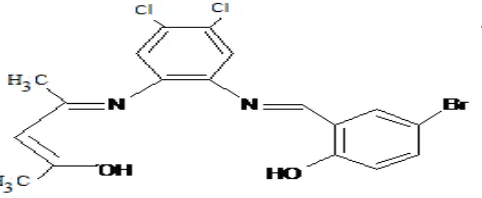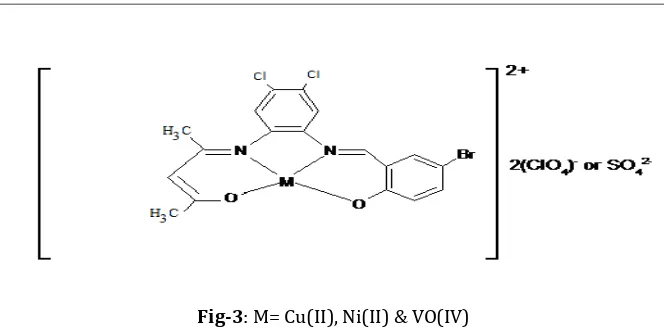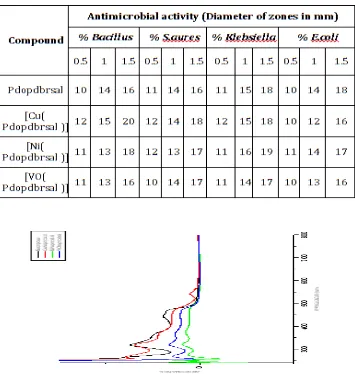© 2017, IRJET | Impact Factor value: 6.171 | ISO 9001:2008 Certified Journal | Page 1519
SYNTHESIS, SPECTROSCOPIC STUDIES AND ANTIBACTERIAL
ACTIVITY OF NOVEL SCHIFF BASE METAL COMPLEXES
N.MAHALAKSMI1, M.R.KUPPUSAMY2, R.SURESHKUMAR3, C.VANITHA4
1,2,3,4
Asst.Professors, PG and Researh Department, Department of chemistry, R.V.Govt. Arts College,
Chengalpattu- 603001, TamilNadu, India
---***---Abstract: Mononuclear Copper(II), Nickel(II) and Oxovanadium(IV) complexes of new tetradendate Schiff base ligand derived from the condensation of 5-Bromosalicylaldehyde, 4,5, dichloro o-phenylenediamine with pentane-2,4-dione have been synthesized and characterized by analytical, spectral and electrochemical methods. The complexes were found to have the general formula [M(L)]X (where M = (Cu(II), Ni(II), and VO(IV) X=ClO4-, (SO4)2- L = mononucleating tetradendate ligand). The
invitro antimicrobial activities of the synthesized compounds have been tested against the gram negative and gram positive bacteria. A comparative study of minimum inhibitory concentration (MIC) values of the Schiff base and its complexes indicate that the metal complexes exhibit higher antibacterial activity than the free ligand.
Key words: Mononuclear, Schiff base, Copper(II), 4,5, dichloro o-phenylenediamine, antimicrobial activities.
1. INTRODUCTION
The transition metals are usually regarded as trace elements as they are present in very small amounts. Metal ions form a variety of complexes with a number of neutral or anionic ligands. The pioneering work of Werner and Jorgensen led to the understanding of the properties of these complexes [1]. One of the most important problems in coordination chemistry is the determination of the nature and the strength of the metal-ligand bond, in relation to the structure and reactivity of the complexes. Coordination compounds have been used as catalyst in many reactions [2]. There is an interest in transition metal complexes of Schiff bases because of the presence of both nitrogen and oxygen and sulphur donor atoms in the backbones of these ligands. In the synthesis and characterization of metal complexes containing Schiff bases as ligands due to their importance as catalysts for many reactions [3– 6]. Tetradentate Schiff base complexes are also important for designing model complexes related to synthetic and natural oxygen carriers [7]. Schiff base metal derivatives attract considerable interest and occupy an important role in the development of the chemistry of chelate systems, especially those with N2O2 tetradentate ligands, due to
the fact that they are closely resembled to proteins. Copper and zinc are well represented in this area [8]. In the coordination geometry and the coordination number of the metal ion. Schiff base and their first row transition metal complex such as Co(II), Ni(II), Cu(II) were reported to exhibit fungicidal, bactericidal antiviral and antibacterial activity [9,10]. In recent years, this has been considerable interest in transition metal complexes containing Schiff bases, mainly due to the fact that they offering opportunities for inducing substrate chirality, turning metal centered electronic factor, enhancing biological activity. Hence, we focus our interest on the 5-Bromosalicylaldehyde, 4,5, dichloro o-phenylenediamine with pentane-2,4-dione containing ligand, the synthesis, spectroscopic and antibacterial studies and analytical characterizations of Copper(II), Nickel(II), and Oxovanadium(IV) complexes are reported herein.
2. Experimental
2.1 Materials and methods
All the chemicals used were chemically pure and AR grade. Solvents were purified and dried according to standard procedures [11]. Metals were purchased from Merck. 5-Bromosalicylaldehyde, 4,5, dichloro o-phenylenediamine & pentane-2,4-dione were obtained from Aldrich. Other chemicals were also purchased from Merck and Aldrich. Synthesis: Caution! Perchlorate salts are potentially explosive and were handled only in small quantities with care.
2.2 Physical measurements
The elemental analysis were carried out with a Carlo-Erba 1106-model 240 Perkin Elmer analyzer. The solution conductivity measurements were performed to establish the charge type of the complexes. The complexes were dissolved in MeCN/DMF/DMSO and molar conductivities of 10-3M of their solutions at 29 0Cwere measured. Infrared spectra were recorded
on the Perkin Elmer FT-IR-8300 model spectrometer using KBr disc and Nujol mull techniques in the range of 4000-400 cm-1.
© 2017, IRJET | Impact Factor value: 6.171 | ISO 9001:2008 Certified Journal | Page 1520
DMF as the solvent. Cyclic voltammetry studies were performed on a CHI760C electrochemical analyzer in single compartmental
cells at 29 0C with H2O/DMSO (95:5) solution using tetrabutylammonium perchlorate (TBAP) as a supporting electrolyte.
2.3 SYNTHESIS OF LIGAND
Preparation of Pdopdbrsal
The Schiff base ligand was prepared according to the known procedure [12]. One mole of orthophenylenediamine was taken in 30ml of ethanol and one milli equivalent of HCl was added and stirred. To this, one mill mole of 5-Bromosalicylaldehyde in 15ml of ethanol was added and refluxed for one hour. The solution was allowed to cool and then neutralized with the requisite volume of standard NaOH solution to exactly neutralize the HCl present in the solution. To this 1 mill mole of pentane-2,4-dione dissolved in 20ml of ethanol was added and refluxed for one hour. The solution was poured in ice and schiff base formed as brown solid was filtered and recrystalized from ethanol.
Fig -1: Structure of Schiff base ligand
2.4 SYNTHESIS OF COMPLEXES
Preparation of copper (II) monomer
The copper (II) monomer of the Schiff base Pdopdbrsal was prepared by refluxing 0.3210g of copper perchlorate hexahydrate with 0.2660g of the ligand in 40ml of ethanol for three hour. The solution was cooled, filtered and left in a petridish to allow the solvent to evaporate slowly. The crystalline complex formed was recrystallized from ethanol yield (0.70g). The same procedure was adopted for the synthesis of other two complexes.
[image:2.595.195.436.276.375.2]M= Cu(II), Ni(II) & VO(IV)
Fig -2: Structure of Schiff base complexes
2.5 ANTIBACTERIAL ACTIVITY
The in vitro antibacterial activity of the ligand and the complexes were tested against the bacteria Klebsiella pneumoniae, Escherichia coli and Staphylococcus aureus by well diffusion method using nutrient agar as the medium. Streptomycin was used as standard for bacteria. The stock solution (10-2 mol L-1) was prepared by dissolving the compound in DMF and the solution was
© 2017, IRJET | Impact Factor value: 6.171 | ISO 9001:2008 Certified Journal | Page 1521
incubated for 24 h for bacteria at 35oC. During the period, the test solution diffused and the growth of the inoculated
microorganisms was affected. The inhibition zone was developed, at which the concentration was noted.
3. RESULTS AND DISCUSSION
The new mononuclear metal complexes of the unsymmetrical Schiff base ligand, Pdopdbrsal are synthesized by refluxing the ligand with the metal salts in 1:1 molar ratio in ethanol medium. All the complexes were found to be stable at room temperature, non-hygroscopic in nature and stable in air. The complexes are decomposed on heating above 280ºC and are found to be almost insoluble in water but soluble in DMF, DMSO, ethanol and dichloromethane. The monomeric complexes have been characterized by nitrogen and metal estimation, Molar conductivity measurements, infrared, electronic, electrochemical and biological studies. The result obtained from these studies and their interpretations to solve the structures are presented below.
3.1. Elemental Analysis
The nitrogen and metal contents of the mononuclear complexes were estimated and the analytical data of these complexes are summarized in table-1. The ligand has four legating sites, two hydroxyl and two azomethine groups and hence binds to the metal ion through these four legating atoms. In these mononuclear complexes, only the –OH moiety group in deprotanated to form a covalent bond with metal and the imine group binds to the metal through its lone pair of electrons. A good agreement is obtained between the experimental and calculated values of the nitrogen and metal contents of the mononuclear complexes of the ligand Pdopdbrsal, based on the above assumption. The structure of the ligand was established with the help of IR. Three metal complexes of this ligand were analyzed for elemental analysis (Metal & N). The colour change of the complexes along with decomposition point >2500 C shows characteristic difference between the Schiff base and metal complexes.
3.2. FT-IR spectrum
IR spectra are useful for the ligands mode of coordination. The selective comparison of IR spectra of the ligand and its metal chelates indicated that the ligand is principally coordinated to the metal ion in two ways, thus acting as a tetradentate ligand. The band appearing at 1625 cm-1 due to azomethine was shifted to a lower frequency by 1-20 cm-1 in the complexes,
indicating participation of azomethine nitrogen in the interaction with the metal ion. A broad band appearing at 3400 cm-1
assigned to the (OH) in the ligand was no longer found in the spectra of the metal complexes but instead a new band appeared at 1345 cm-1, indicating deprotonation and coordination of hydroxyl oxygen with the metal ion. Another feature observed in
IR spectra, the perchlorate gives rise to two IR bands, a weak band at 930-920 cm-1 due to symmetric stretching mode
(IR-forbidden) and an asymmetric stretching mode at 1180- 1070 cm-1 (IR-allowed). This shows that ClO4- ion has Td-symmetry
and is ionic [13,14]. The oxovanadium(IV) complexes exhibit an intense band at 980cm-1, which has been assigned to the
(V=O) stretching frequency [15]. Further conclusive evidence of the coordination of the ligand with metal ions was shown by the appearance of new weak low frequency bands at 465 cm-1 and 520cm-1. These were assigned to (M-N) and (M-O)
vibrations, respectively. The new bands were only observable in the spectra of metal complexes and not in the spectra of ligand, thus confirming the participation of groups (hydroxyl oxygen and azomethine nitrogen) in coordination. The datas are given in table-2.
3.3. UV-Vis spectrum
The UV-Vis spectra of ligand and its complexes have been taken in DMSO solution between 200-800nm. The Schiff base ligand Pdopdbrsal exhibits two bands at 245 and 305nm. The inner ligand transitions such as π→π * and n→π* are common due to the presence of C=N, and C=O groups in the ligand structure [16,17]. In addition, the mononuclear complexes show a new band around at 430 nm which is assigned to the ligand-to-metal charge transfer transition between the highest occupied ligand molecular orbital and the lowest empty d-orbital of the metal. The near IR region showed no absorption upto 1000 nm. The metal complexes absorb strongly in the UV region and in addition showed at least one peak in the visible region. The bands of very low intensitiy in the visible region are assigned to d-d transition. The copper(II) complex exhibits a characteristic shoulder at 540 nm. This absorption is attributed to the square planar geometry of the copper(II) complex[18,19]. The nickel complex shows d-d bands below 510 nm which suggests a square planar geometry around nickel (II) [20]. The datas are given in table-3 and the spectra are reproduced in figure-4.
3.4. Molar Conductance studies
© 2017, IRJET | Impact Factor value: 6.171 | ISO 9001:2008 Certified Journal | Page 1522
two weeks. The conductivity increased very slightly with time in DMSO for all the complexes. The present coordination moieties cannot be replaced by the solvent molecules. The value of these conductance’s are in the range 25-30 ohm-1 cm2 mol-1 in DMSO
and are in accordance with those reported for electrolyte in this solvent. This is indicative that these complexes dissociate very slightly in this solvent. As observed in the IR spectra, where the compounds were formulated as electrolytes the molar conductivities show that all the anions are present outside the coordination sphere in solution [21-26]. The datas are given in table-1.
3.5 Cyclic Voltammetry
The redox behaviour of the complexes was characterized using cyclic voltammetry. The complexes were dissolved in DMSO. The working and counter electrode was platinum. The reference electrode is calomel. The potential range is 1.2
to -0.2V. The datas are given in table-3 and the spectra are reproduced in figures 5-8.
3.6. Anti-Bacterial Activity
Free ligand and its metal complexes were tested against the bacterial species by using well diffusion method [27]. From the table-4 it is concluded that all of the metal complexes exhibit moderate and higher activity than the free ligand. The activity increases with increase of concentration of the test solution containing new complexes.
Biological activity of the complexes
The comparison of the biological activities of the synthesized compounds shows the following results, 1. The free ligand and its metal complexes show positive effects towards Eserchia coli.
2. The free ligand copper (II) show higher antibacterial activity against both negative bacteria because of effective chelation that is more sable.
3. Free ligand, copper (II) and oxovanadium (IV) complexes have higher biological activity than the nickel (II) complexes.
From all of the above results we conclude that the metal complexes have higher biological activity than the free ligand because of chelation. On chelation [28], the polaritiy of the metal ion is reduced to a greater extent due to the overlap of the ligand orbital and partial sharing of the positive charge of the metal ion with donor groups further, it increases the delocalization of π –electrons over the whole chelate ring and enhances the lipophilicity of the complex. The increased lipophilicity enchances the penetration of the complexes into lipid membranes and blocking of metal binding sites on the enzymes of the microorganisms.
4. CONCLUSIONS
Unsymmetrical Schiff base ligand was prepared by reacting 5-Bromosalicylaldehyde, 4,5, dichloro o-phenylenediamine & pentane-2,4-dione. This Schiff base was reacted with metal salts in alcoholic medium and they resulting deep blue/ green complexes isolated. The metal and ligand ratio of 1:1 has been arrived at by estimating the nitrogen and metal contents. The complexes are ionic as indicated by the conductivity in DMF and DMSO solutions which is further supported by IR spectra showing peak at1100cm-1 region. The infrared spectra also indicates that the involvement of the phenolic oxygen and the
nitrogen of azomethine group binding of the ligand to the metal atom. The electronic spectral studies indicates that the d-d transition of Cu (II), Ni(II) and oxovanadium(IV) complexes are responsibility for the appearance of a band in the visible region. The electrochemical studies show the redox potential for the Cu (II), Ni(II) and Oxovanadium(IV) ions, thus confirm the presence of these metal ions in the mononuclear complexes. All the complexes undergo reduction or oxidation and the reduction potentials are influenced by the ligand ring size The ligand system in ideally suited for stability of the +2 oxidation state of copper and nickel whereas +4 for vanadium complexes. The complexes have more antibacterial activity than the free ligand because of chelation. The biological activity increases with increase in the concentration of the test solution containing new complexes.
© 2017, IRJET | Impact Factor value: 6.171 | ISO 9001:2008 Certified Journal | Page 1523
[image:5.595.138.470.81.246.2]Fig-3: M= Cu(II), Ni(II) & VO(IV)
[image:5.595.102.509.283.489.2]Table -:1 Analytical and molar conductivity values of Pdopdbrsal and its metal complexes
[image:5.595.101.509.285.486.2]© 2017, IRJET | Impact Factor value: 6.171 | ISO 9001:2008 Certified Journal | Page 1524
[image:6.595.121.476.355.729.2]Table :3 UV-Visible and Cyclic voltametric data of Pdopdbrsal and its metal complexes
Table -:4 Antimicrobial activity data’s of Pdopdbrsal and its metal complexes
© 2017, IRJET | Impact Factor value: 6.171 | ISO 9001:2008 Certified Journal | Page 1525
Fig-5: Cyclic voltammogram of Pdopdbrsal
Fig-6: Cyclic voltammogram of [Cu(Pdopdbrsal)]
© 2017, IRJET | Impact Factor value: 6.171 | ISO 9001:2008 Certified Journal | Page 1526
Fig-8: Cyclic voltammogram of [VO(Pdopdbrsal)]
REFERENCES
[1] J.E. Huheey, “Inorganic Chemistry”, Third Ed. Harper and Row, p.359 (1983).
[2] M.M.T. Kahn and A.E. Martell, “Homogeneous Catalysis by metal complexes”, Vol. 1 and 2, Academic Press (1974).
[3] P. K. Battacharya, Proc. Indian Acad. Sci. (Chem. Sci.), (1990), Vol 102, pp247.
[4] N. S. Enikolopyan, K. A. Bogdanova, K. A. Askarov, Russ. Chem. Rev, (1983), Vol 52, pp13-26.
[5] W. H. Leung, C. M. Che, Inorg. Chem, (1989), Vol 28, pp4116-4121.
[6] A. M. El-Hendawy, A. H. Alkubaisi, A. El-Ghany, K. El-Kourashy, M. N. Sharab, Polyhedron , (1993),Vol 12, pp2343-2350.
[7] P. J. McCarthy, R. J. Hovey, K. Ueno, A. E. Martell, J. Am. Chem. Soc, 1955, Vol 77, pp5820-5824.
[8] R.H. Prince, Comprehensive Coordination Chemistry, 1987, Vol 5, Pergamon Press, Oxford, UK.
[9] J.E. Weder, C.T. Dillon and T.W. Hambely Rev Rev.232,(2002).95,
[10] M.A. Zoroddu, Zorroddu and S. Zanetti, R. Pogni, R. Basosi, J. inorg.Biochem.63, (1996).
[11] A.I. Vogel, Text Book of Practical Organic Chemistry, 5th ed., Longman, London,(1989).
[12] S.Manjunathan, Ph.D., thesis, Annamalai University, (2002).
[13] K. Nakamoto, Infrared and Raman Spectra of Inorganic and Coordination Compounds, John Wiley & Sons, New York, (1978).
[14] B.Kaitner and G.Parlovic C. Chemica Acta.72,607(1999).
[15] A.B.P. Lever, Inorganic Electronic Spectroscopy, Elsevier, Amsterdam, (1968).
[16] B.T. Thaker, K.R. Surati, J. Coord. Chem. 59 (2006) 1191.
[17] C.J. Ballhausen, Introduction to Ligand Field Theory, McGraw-Hill, New York, (1962).
[18] A.B.P. Lever, Inorganic Electronic Spectroscopy, Elsevier, Amsterdam, (1968).
© 2017, IRJET | Impact Factor value: 6.171 | ISO 9001:2008 Certified Journal | Page 1527
[20] A.T. Colpas and J.P. Redfern, Nature, 201, 68 (1964).
[21] A. Muller, M. Peng, E. Krichmeyer and H.Walberg, J.Angew chem. Int. Ed. Engl.,27,1719 (1988).
[22] A.Muller, R. Rohlfing, J. Doring and M. Penk. J. Angew chem., Int. Ed. Engl., 30, 588 (1991).
[23] Q. Chen, D.P. Gosham, C.P.Scholes, X.Tan and J.Zubieta, J.Am.chem. Soc., 114, 4667 (1992).
[24] M.I. Khan, Q.Chen, D.P. Gosham and J.Zubieta, J.Inorg. Chem., 32, 672 (1991). [25] M.J. Pelezar, E.C.S. Chan and N.R. Krieg ,“Microbiology”, 5th edition, Wiley Interscience, New York, (1983).
[26] Willson and Gisvold, Text Book of Organic Medicinal and Pharamaceutical Chemistry. 9th Edn., J.B. Lippin Colt Co., 1 (1991).
[27] C. Perez, M. Pauli and P. Bazevque, Acta. Biol, Med. Exp. 15, 113 (1990).


